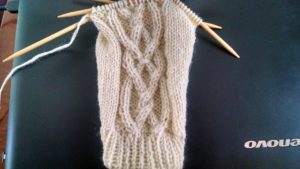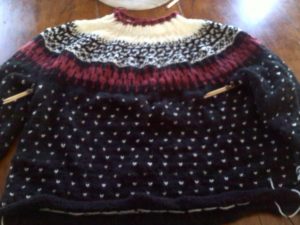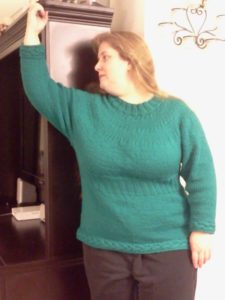About five years ago, I got good enough at knitting that I finally felt like I was producing something good enough to give as a present. I knitted about three sweaters for my mother, two or three for my son and one for my dad (those being the family members that like 100% wool sweaters. Between laundry habits and sensory tastes, other family members aren’t really into them, so I do other things that they are more likely to like for gifts).
I was looking at my sweater drawer and considering buying some, as the sweaters I’ve made for myself are looking a bit worn and old. These sweaters are between seven and eleven years old, and have been worn a great deal, what with me living in Northern New England and all. They were also made of Wool-Ease so I could put them in the washer and dryer. *snerk* Well, that’s what they say. I was not happy with the results over time.. Anyway, most of my sweaters are a bit ratty.
The newest sweater I have was knit about three years ago. It’s 100% wool and has been cared for properly. I love it and want it to last, but it is really my only “good” sweater. (As defined as something I’m okay with wearing to work!) Which means I am going to wear it out of I do not put some more sweaters into rotation.
So, I’ve declared 2016 the Selfish Knitting Year and I am going to knit some sweaters I’ve been meaning to for myself – sweaters that I can wear to an office.
 The first one I’ve started on is going to be a modified Aran. Being deep-bodied, I’m not going as hard core on the cabling as I want to, as I don’t want to look like a gorilla or something. But I am going to make it in the traditional cream-colored wool. I’m using Lion’s Brand Fisherman’s wool, which is a pretty decent workhorse yarn.
The first one I’ve started on is going to be a modified Aran. Being deep-bodied, I’m not going as hard core on the cabling as I want to, as I don’t want to look like a gorilla or something. But I am going to make it in the traditional cream-colored wool. I’m using Lion’s Brand Fisherman’s wool, which is a pretty decent workhorse yarn.
I’ve always wanted a good Aran sweater, but them suckers is expensive if you buy the authentic deal.
The picture is the beginning of a sleeve. What I’m secretly doing is using my time with knitting the sleeve as a gauge check. I did knit a gauge swatch with the cables I intend to use, but I’m double-checking it by starting on a sleeve first. Less expensive in time if I notice an egregious error in the calculation early on! I never use a commercial pattern when I knit. Ever since I read Knitting Without Tears, I’ve kind of been ruined for them. Elizabeth Zimmerman’s seamless sweater concept is enough of a template that I can do pretty much anything I like with a sweater after I give it some thought.
That said, no, I most emphatically cannot intuit how cables work. The cable at the left is the Clustered Braid from A Second Treasury of Knitting Patterns by Barbara Walker. It’s what knitters call a stitch dictionary – hundreds of stitch patterns, cables, and lace patterns that you can use to make the blank pattern of a bog-standard Seamless Raglan Sweater into a unique creation.
I’m hoping to get this done while it is still cold enough to wear it. Starting a sweater in January, especially one with cables, is a bit risky for this. But hey, what is life without a little risk?
 My next sweater will be a good Norwegian one – black with white ljus and red at the collar. Since I really do want to feel free to wear it to work, I am totally waffling on whether or not do use a skulls pattern in the yoke or not. Maybe I should wear my Skulls of My Enemies socks sometime and see what the reaction is. Otherwise, it would be quite similar the sweater at the right with enough variation not to be an actual copy. I made that one for my mom some years ago, and it’s still one of the knits I am most pleased with. Still, I can’t get the idea of replacing that red and black band with skulls and doing a red moving to white motif at the upper yoke out of my head.
My next sweater will be a good Norwegian one – black with white ljus and red at the collar. Since I really do want to feel free to wear it to work, I am totally waffling on whether or not do use a skulls pattern in the yoke or not. Maybe I should wear my Skulls of My Enemies socks sometime and see what the reaction is. Otherwise, it would be quite similar the sweater at the right with enough variation not to be an actual copy. I made that one for my mom some years ago, and it’s still one of the knits I am most pleased with. Still, I can’t get the idea of replacing that red and black band with skulls and doing a red moving to white motif at the upper yoke out of my head.
 If I really get my knit on (and I might. I’m taking quite a long train trip in August) I want to make one more sweater for myself this year. I am not quite sure what kind, but I think I need one more sweater in a bright, flattering color. My aqua one is awesome, so something a little like that in a purple or some other color I see in my general clothing color palette. I have a book of edgings that might be cool to try for it.
If I really get my knit on (and I might. I’m taking quite a long train trip in August) I want to make one more sweater for myself this year. I am not quite sure what kind, but I think I need one more sweater in a bright, flattering color. My aqua one is awesome, so something a little like that in a purple or some other color I see in my general clothing color palette. I have a book of edgings that might be cool to try for it.

